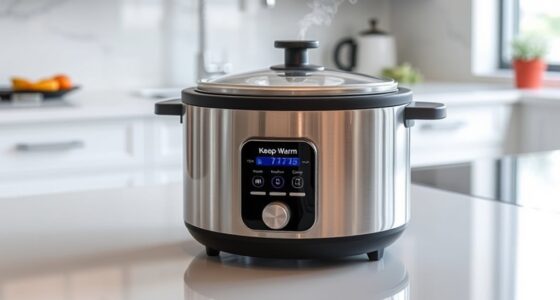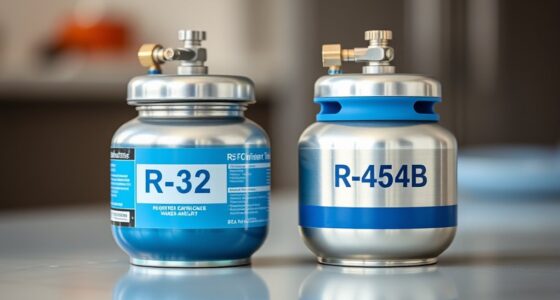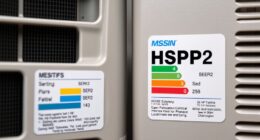If your steam iron is spitting rust and residue, it’s likely due to mineral buildup from hard water. To fix this, descale your iron using a mixture of equal parts white vinegar and water or a manufacturer-approved descaling solution. Regularly cleaning and using distilled water can prevent future problems. Proper maintenance is key to keeping your soleplate rust-free and functioning well. Continue to explore ways to protect your iron and keep it in top shape.
Key Takeaways
- Descale your iron regularly using a vinegar-water solution or manufacturer-recommended descaling agents to remove mineral buildup.
- Use distilled water instead of tap water to prevent mineral deposits and rust formation inside the soleplate.
- Unplug, cool, and clean the soleplate with a damp cloth or vinegar solution to remove rust stains and residue.
- Store the iron in a dry, cool place with the soleplate facing up to prevent rust and moisture accumulation.
- Apply a thin layer of mineral oil or soleplate protectant after cleaning to prevent future rust and mineral deposits.
Understanding Why Your Iron Spits Rust and Residue
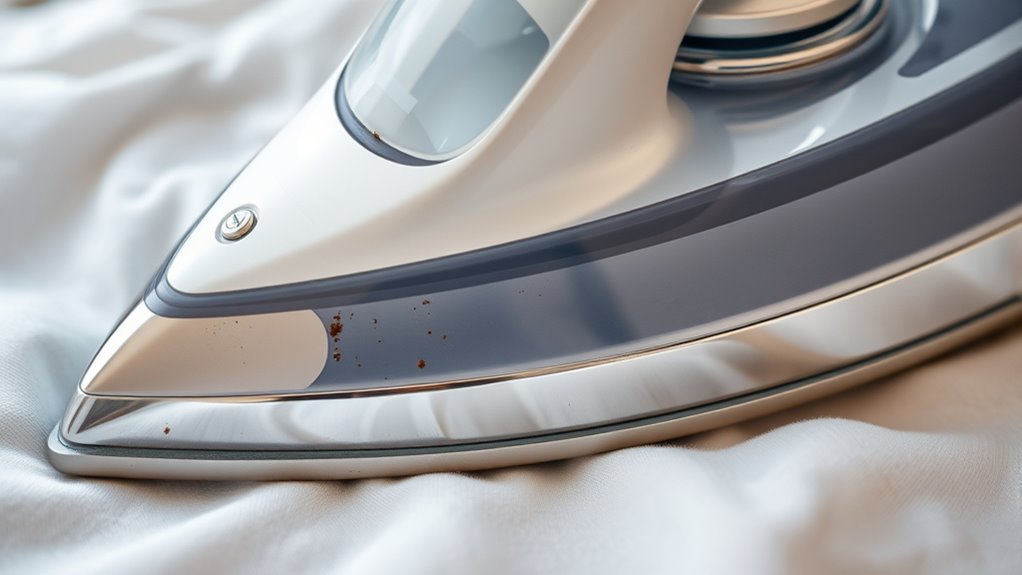
If your iron is spitting rust and residue, it’s often due to mineral buildup inside the device. Hard water contains minerals like calcium and magnesium, which accumulate over time, forming deposits inside the water tank and steam vents. When you heat the iron, these minerals can loosen and get expelled along with the steam, causing rust-colored spots and residue to appear on your clothes. This buildup also clogs the steam vents, reducing efficiency and potentially damaging the soleplate. Using unfiltered or hard water accelerates this process. Regularly cleaning your iron and avoiding mineral-rich water can prevent these issues. Understanding this buildup helps you take steps to keep your iron functioning well and protect your garments from unwanted stains. Additionally, using descaling solutions designed for appliances can help dissolve mineral deposits and maintain optimal performance. Incorporating water softening methods can further reduce mineral content and extend the lifespan of your iron.
Signs That Indicate Your Iron Needs Descaling

You can tell your iron needs descaling when it starts to produce less steam or no steam at all, even on the highest setting. This indicates mineral buildup blocking the steam vents, reducing efficiency. You might notice water leaking or dripping from the soleplate instead of steam. Another sign is uneven steam distribution, causing inconsistent ironing results. If your iron’s performance suddenly drops or the soleplate looks dull and discolored, it’s a clear sign that mineral deposits are accumulating inside. Additionally, if you see rust stains or brownish spots on your fabric after ironing, it suggests rust or debris is coming from the iron. These signs mean it’s time to descale your iron to restore proper function and avoid further damage. Regular maintenance and descaling methods are essential to prevent mineral buildup from impairing your iron’s performance. Proper scale removal techniques can help ensure your iron remains in optimal working condition. Being aware of steam vent blockages, including rust deposits, can help you take timely action before damage occurs.
How to Properly Descale Your Steam Iron
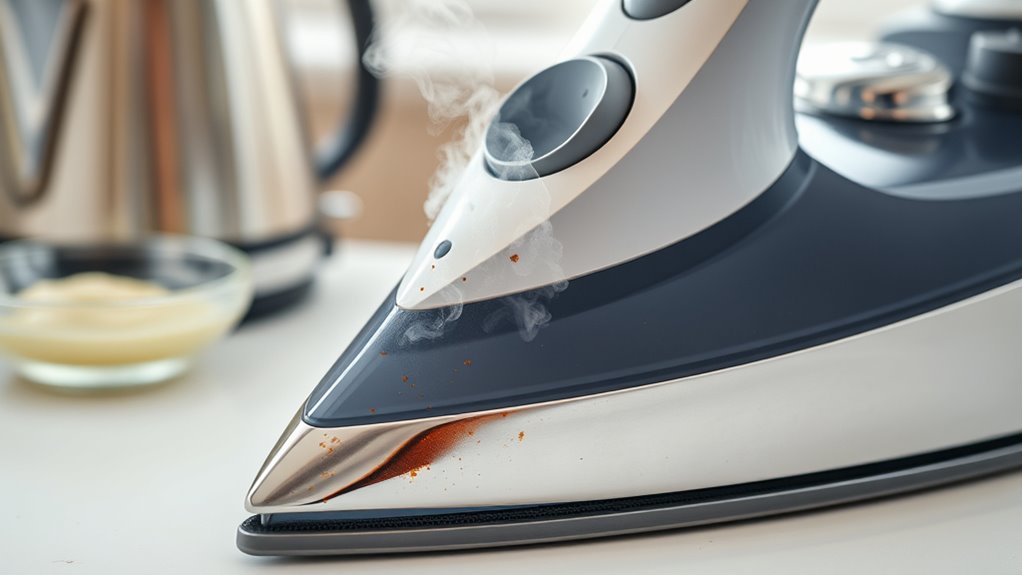
To keep your steam iron in top shape, it’s important to use descaling solutions regularly. Follow a consistent maintenance routine to prevent mineral buildup and rust. Proper descaling techniques guarantee your iron works efficiently and lasts longer. Additionally, choosing the right descaling products can help protect the soleplate and maintain optimal steam performance. Water quality and flow rate are crucial factors that influence how often you need to descale your iron.
Use Descaling Solutions
Descaling your steam iron correctly guarantees it functions efficiently and prevents rust buildup. Using the right descaling solutions is key to removing mineral deposits effectively. First, choose a commercial descaler designed for irons or use a mixture of equal parts white vinegar and water. Second, fill the water tank with the solution and turn on the iron to heat it up. Third, press the steam button to allow the solution to flow through the soleplate, helping break down scale. Fourth, empty the tank completely and rinse thoroughly with clean water to remove any residue. This process ensures your iron stays free of mineral buildup and rust, keeping it in top shape for longer. Proper descaling with the right solutions is essential for smooth, safe steaming. Additionally, regularly inspecting the soleplate for signs of corrosion or damage can help maintain its performance and prevent rust formation.
Regular Maintenance Practices
Regular maintenance is essential to keep your steam iron in ideal condition and prevent rust from forming. To do this, regularly empty the water reservoir after use to avoid mineral buildup. Descale your iron at least once a month, especially if you notice reduced steam performance or visible deposits. Use a mixture of equal parts water and white vinegar or a commercial descaling solution, and run the iron on the steam setting until the mixture is expelled. Afterwards, rinse thoroughly with clean water to remove any residue. Wipe the soleplate with a soft cloth to remove any remaining deposits. Always follow your manufacturer’s instructions for descaling and maintenance. Proper care guarantees your iron stays rust-free, functions efficiently, and prolongs its lifespan.
Tips for Preventing Rust and Mineral Buildup
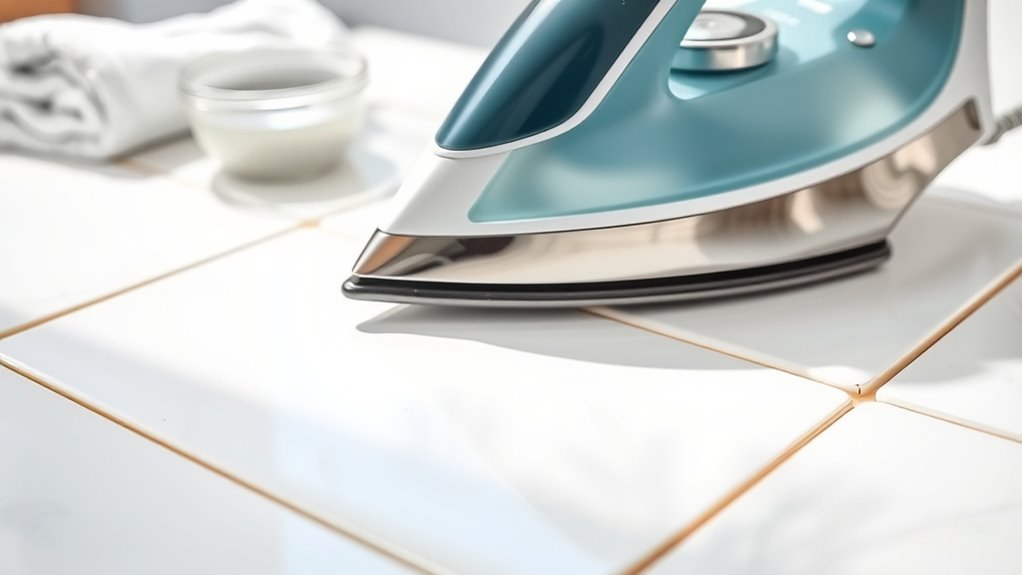
Preventing rust and mineral buildup in your steam iron starts with proper maintenance and usage habits. First, always use distilled water instead of tap water, which contains minerals that cause buildup. Second, empty the water reservoir after each use to prevent standing water that promotes rust. Third, regularly check and clean the iron’s steam vents to avoid clogs. Fourth, consider using appropriate cleaning solutions designed for irons to help dissolve mineral deposits and maintain optimal performance. Additionally, storing your iron in a dry, cool place with the soleplate facing up helps prevent moisture accumulation. Incorporating descaling products specifically formulated for steam irons can further prevent mineral buildup over time. Using a descaling process periodically can help keep the internal components free of deposits and extend the lifespan of your appliance. Following these simple tips helps extend your iron’s lifespan and keeps it functioning efficiently. By staying proactive, you minimize rust formation and mineral deposits, ensuring smooth steaming and crisp results every time. Consistent care now saves you time and money on repairs later.
Safely Cleaning and Protecting the Soleplate
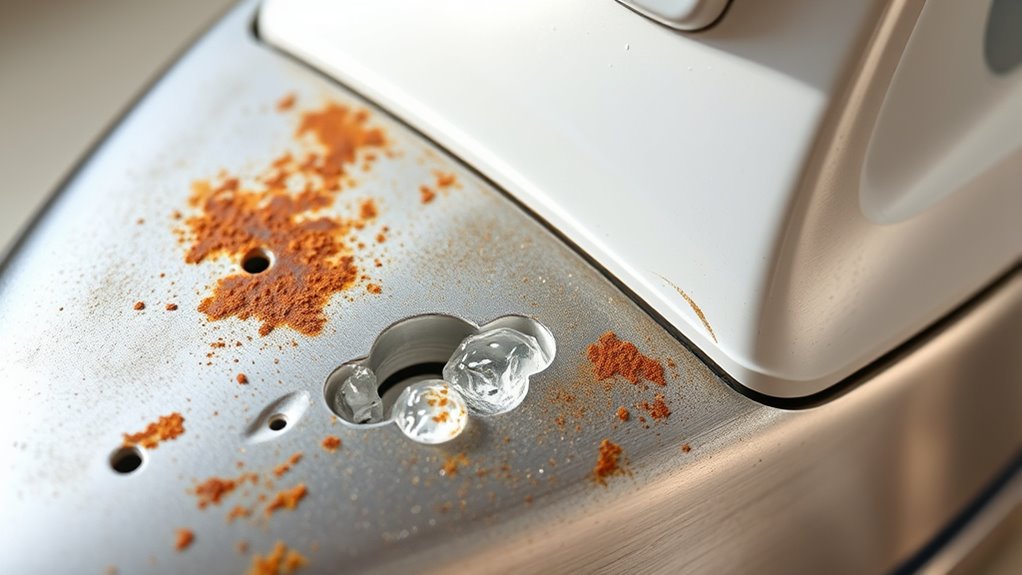
To keep your soleplate in top shape, use gentle cleaning methods that won’t damage the surface. Regularly applying protective maintenance tips can help prevent rust and buildup. With proper care, your iron will last longer and perform better every time you use it. Incorporating cultural awareness about the importance of maintenance can also extend the lifespan of your appliance. Ensuring correct storage and avoiding exposure to moisture are additional preventive measures that can help maintain your iron’s performance. Additionally, understanding the rust formation process can help you take targeted steps to avoid corrosion and keep your soleplate smooth. Exploring repair techniques can also be beneficial if issues arise, allowing for cost-effective solutions. Recognizing technological innovations in cleaning and protection techniques can further enhance your appliance’s longevity.
Gentle Cleaning Methods
Cleaning your iron’s soleplate gently is essential to avoid damage and keep it functioning smoothly. Using harsh abrasives can scratch the surface, making it harder to remove rust or stains. Instead, opt for safe, mild methods.
Here are four effective techniques:
- Soft cloth and water — Wipe with a damp cloth to remove surface dirt.
- Baking soda paste — Mix baking soda with water and gently scrub stubborn spots.
- Vinegar-soaked cloth — Wipe the soleplate to break down mineral deposits.
- Magic eraser — Lightly rub to lift stains without scratching.
Always unplug the iron and let it cool before cleaning. Using proper maintenance techniques can help prevent rust buildup and extend the life of your appliance, especially since electric heated mattress pads are designed for safety and durability when used and maintained properly.
Protective Maintenance Tips
Regularly protecting your iron’s soleplate helps maintain its performance and prevents rust buildup. To do this, always unplug the iron before cleaning and avoid abrasive materials that could scratch the surface. Use a damp microfiber cloth or a specially designed soleplate cleaner to wipe away any residue or mineral deposits gently. Applying a thin layer of mineral oil or a dedicated soleplate protectant can help prevent rust and keep the surface smooth. Store your iron in a dry, cool place, and avoid leaving water in the reservoir when not in use for extended periods. Regularly inspecting the soleplate for signs of rust or damage allows you to address issues early, ensuring your iron stays in top condition and prolongs its lifespan. Additionally, understanding WWE Raw’s Financial Impact reveals how maintaining equipment like your iron can be part of broader financial management strategies to preserve valuable assets. To further prevent rust formation, consider using distilled water in the reservoir to minimize mineral deposits and proper storage techniques to avoid moisture buildup.
Best Practices for Maintaining Your Iron’s Performance
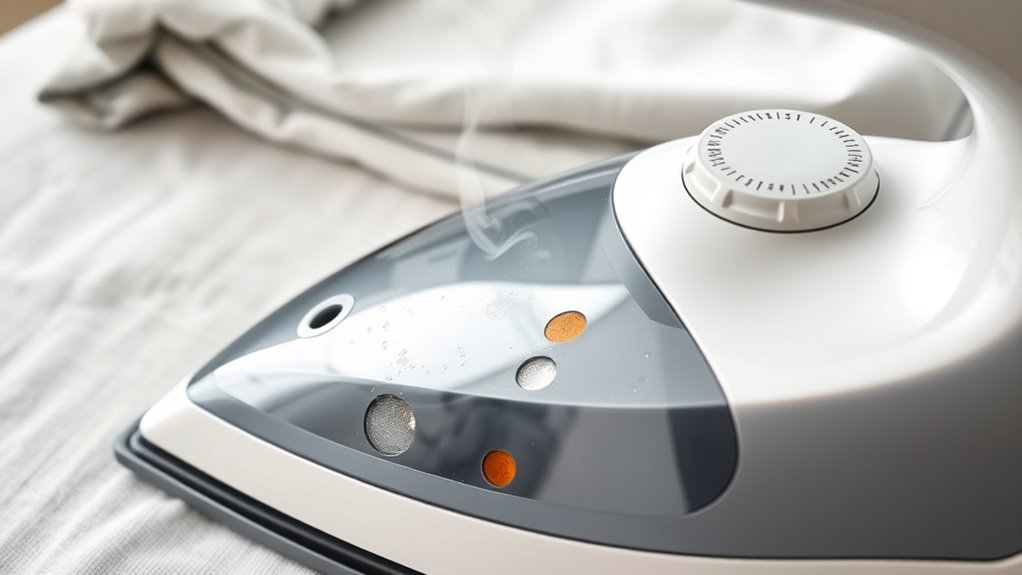
Maintaining your iron’s performance requires consistent care and proper usage. To keep it running smoothly, follow these best practices:
- Clean the soleplate regularly with a damp cloth or vinegar solution to prevent buildup.
- Use distilled water instead of tap water to reduce mineral deposits and rust.
- Empty the water reservoir after each use to prevent standing water and mineral buildup.
- Descale periodically with manufacturer-recommended descaling agents to remove mineral deposits and avoid spitting or rust.
Frequently Asked Questions
Can Using Tap Water Cause My Iron to Rust Faster?
Yes, using tap water can cause your iron to rust faster. Tap water often contains minerals like calcium and iron, which can build up inside the iron over time. This buildup may lead to rust spots and reduce the iron’s efficiency. To prevent this, you should use distilled or demineralized water, especially if your tap water is hard. Regularly descaling your iron also helps maintain its longevity and performance.
How Often Should I Descale My Steam Iron?
You should descale your steam iron every 1-3 months, depending on how often you use it and the water hardness in your area. If you notice reduced steam performance or mineral buildup, it’s time to descale sooner. Regular descaling prevents rust, mineral deposits, and spitting. Use a descaling solution or a mixture of vinegar and water, and follow your manufacturer’s instructions to keep your iron in top shape.
Are There Specific Products Recommended for Descaling Irons?
You should use descaling products specifically designed for irons, such as Lime-A-Way or CLR. These products effectively dissolve mineral build-up and prevent rust. Always follow the manufacturer’s instructions for safe use. Additionally, some brands offer specialized descaling solutions for steam irons. Using these recommended products helps keep your iron in top condition, prevents spitting rust, and extends its lifespan.
Will Descaling Damage the Soleplate or Internal Components?
Descaling usually won’t damage your soleplate or internal parts if you follow proper procedures. Use gentle descaling agents like vinegar or commercial descalers recommended by the manufacturer. Avoid harsh chemicals or abrasive pads that could scratch or corrode surfaces. Always unplug your iron, let it cool, and follow the instructions carefully. Regular descaling keeps your iron functioning smoothly without risking damage to its components.
How Can I Tell if My Iron’s Soleplate Is Corroded?
Like a ship’s hull showing rust, your iron’s soleplate reveals corrosion through discoloration, rough patches, or rust spots. You might notice brown or reddish stains, uneven surface texture, or even slight pitting. If you see these signs, it’s time to clean and descale your iron. Regular maintenance prevents further damage, ensuring your iron stays smooth and effective, just like a well-maintained vessel ready to sail smoothly.
Conclusion
If your iron’s spitting rust again, don’t ignore the warning signs. Proper descaling and maintenance can extend its life and keep your clothes spotless. But what if hidden mineral deposits are lurking beneath the surface, threatening future damage? Staying vigilant and following these steps not only solves the problem now but also guards against surprises down the line. The real question is—are you ready to release the iron’s full potential before it’s too late?



